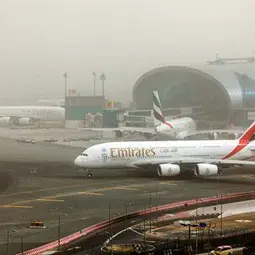World’s dusty airports degrade aircraft engines
23 May 2022
MUNICH — The ominous approach of a sky-high haboob can fray the nerves of travelers awaiting flights out of the world’s desert airports. As air traffic continues its decades-long increase — after a brief COVID-19 hiatus — dust is a growing concern within the aviation industry. Until now, aircraft operators and manufacturers did not know just where, when and how much dust was passing into engines, says Claire Ryder, an Associate Professor and Natural Environment Research Council (NERC) Independent Research Fellow at the University of Reading.
Ryder will talk about how much dust aircraft encounter at some of the world’s major airports this week at the European Geosciences Union (EGU) General Assembly 2022.
Though dust generally does not pose an immediate safety threat, it can cost carriers engine efficiency and extra maintenance time. The fine particles build up on surfaces and slowly erode or corrode internal engine components. “Technological developments in engines in recent years mean the engines are more sensitive to damage from dust,” Ryder says.
Aircraft manufacturers need to know where the dust is geographically and within the atmospheric column and when it is most concentrated, Ryder says. “Since aircraft spend different amounts of time and engine power at different altitudes, knowing how dust concentration changes with height is crucial.”
The researchers profiled the conditions above 10 relatively dusty major airports around the world between 2003 and 2020 using the Copernicus Atmospheric Monitoring System (CAMS). With data from the Cloud-Aerosol Lidar and Infrared Pathfinder Satellite Observation (CALIPSO) mission to verify the vertical variation in dust, Ryder, Clément Bezier of Météo-France and colleagues determined the dose of dust an airplane engine receives during departure and arrival.
Airports that are close to desert-like conditions, such as in Dubai and Delhi, see year-round dust close to the surface, Ryder says. But at these locations, daily temperature fluctuation strongly affects dust concentrations; warmer daytime temperatures drive convection in the atmosphere, kicking up more dust than in the cooler evenings. In Dubai, nighttime dust concentrations at ground level can be 20% less than during the day, according to the researchers.
The amount of dust sucked into engines depends on flight phase and engine conditions. “Ground-based dust dose is much higher for ascent than descent, because before take-off, the aircraft spends more time with the engine running at high power,” Ryder explains. Having planes take off during the cooler nighttime hours could reduce engine dust.
Similar convection cycles affect the distribution of dust in the atmosphere over the course of a year. Seasonal plumes bring particles high into the atmosphere in some locations, which can affect aircraft holding for landing. “During descent, the holding pattern contributes most to the dose because this tends to be at altitudes (~1-3 kilometers) where dust concentrations are very high,” Ryder says.
Planes stopping in Dubai, Delhi and Niamey, Niger, ingest the most dust of the locations in the study, though seasonal and daily variations can be significant. Airports such as Sydney, Phoenix and Bangkok see less dust than the others, but they do experience occasional large dust storms. However, these events do not contribute a significant dose to engines over the long term, Ryder says.
To reduce engine dust, the researchers say air traffic controllers need to consider their airport’s specific setting, the season, and the time of day.
To learn more about how engine dust could be reduced by making small changes, check out the presentation at 11:12 CEST on 23 May at the EGU22 meeting.
More information
When reporting on this story, please mention the EGU General Assembly 2022, which is taking place from 23-27 May 2022. This paper will be presented in session AS3.10 on Monday, 23 May, 13:20-14:36 CEST. If reporting online, please include a link to the abstract: https://meetingorganizer.copernicus.org/EGU22/EGU22-2465.html.
Press release text by Jennifer Schmidt.
Contact
Gillian D’Souza
EGU Media and Communications Officer
Munich, Germany
media@egu.eu

